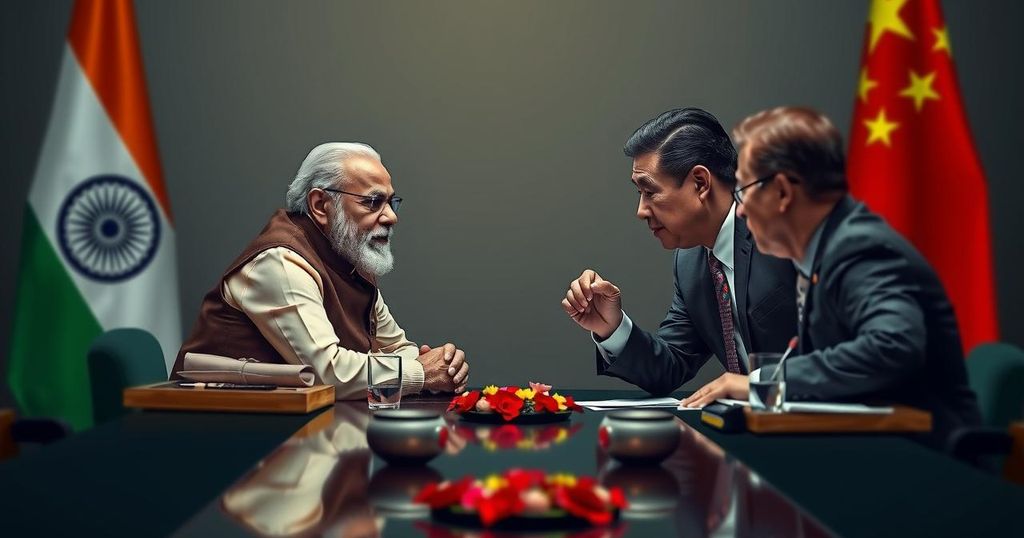India has announced the end of its four-year border dispute with China, allowing for regular patrols along their contested Himalayan border. The agreement follows a series of violent clashes that notably culminated in June 2020, leading to the deaths of soldiers from both countries. A bilateral meeting between Indian Prime Minister Narendra Modi and Chinese President Xi Jinping is expected shortly, highlighting the significance of this thaw in relations amid geopolitical tensions and historical distrust between the nations. Experts urge caution, as the lack of trust remains a critical issue that could precipitate future conflicts.
The recent announcement by India regarding the conclusion of its prolonged border dispute with China has generated a cautiously optimistic atmosphere among observers. Following a four-year period characterized by heightened tensions, particularly stemming from violent clashes in the Galwan Valley in June 2020, it appears that both nations have agreed to re-establish regular patrols along their contentious Himalayan border, a development confirmed by China’s Foreign Ministry spokesperson a day following India’s declaration. This diplomatic thaw has opened avenues for renewed dialogue, notably a bilateral meeting between Indian Prime Minister Narendra Modi and Chinese President Xi Jinping, anticipated to occur during the forthcoming Brics summit in Russia. The last formal interactions between these leaders took place during the Group of 20 meeting in Bali in 2022, making any renewed engagement a significant milestone. The geopolitical landscape has evolved considerably since 2020 when the two countries first exchanged gunfire in four decades, following years of military deployments and escalating hostilities along their 3,488-kilometer-long border, known as the Line of Actual Control. A resolution to this friction is seen not only as essential for regional stability but also advantageous for both countries, as India aims to redirect military resources amidst increasing tensions in its disputed regions with Pakistan, whilst China would benefit from alleviating one of its immediate security concerns, potentially diverting focus to other territorial disputes. The ramifications of the 2020 clashes prompted India to impose restrictions on Chinese investments and limit bilateral interactions, creating a rift that had severe socio-economic implications for both nations. Despite the recent conciliatory gestures, experts emphasize the precarious nature of this agreement, recalling similar past instances of disengagement that fell short of fostering lasting peace. A significant concern remains the lingering distrust between the two nuclear-capable nations, which makes continued vigilance imperative to prevent any missteps that could escalate into renewed conflict. Ultimately, while the announcement signifies a step toward stabilization, the path ahead is fraught with uncertainties and requires careful navigation.
The background of this article centers on the longstanding territorial disputes between India and China, which have a complex history including a war in 1962 and frequent border skirmishes. The recent clashes in 2020 at locations such as the Galwan River region marked a notable escalation in hostilities, leading to military buildups and heightened tensions that alarmed regional observers. Connectivity and trade relations have been significantly affected in the aftermath, with India introducing numerous restrictions on Chinese investments and enforcing bans on various applications. This friction has implications not only for India and China but also extends to international dynamics, particularly in relation to the United States, which has been seeking to strengthen alliances with nations like India to counterbalance China’s influence.
In conclusion, while India’s announcement regarding the conclusion of its four-year border dispute with China appears to be a positive development in enhancing diplomatic relations between the two countries, the underlying tensions and issues of trust must not be overlooked. The agreement to resume patrols and the planned meeting between leaders signify a willingness to engage; however, historical precedents of unresolved territorial disputes and lingering distrust point to the necessity for cautious optimism. Both nations must navigate this complex relationship delicately to ensure that improvements in dialogue do not result in unintended escalations. The international community, particularly the United States, will be closely monitoring these developments as they could reshape the geopolitical landscape in the region.
Original Source: www.business-standard.com






